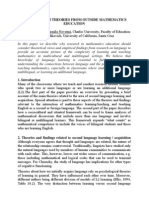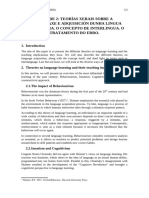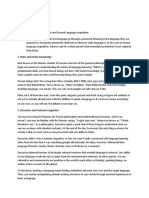Prior Knowledge Effects in SLA
Prior Knowledge Effects in SLA
Uploaded by
Chris KhonngamCopyright:
Available Formats
Prior Knowledge Effects in SLA
Prior Knowledge Effects in SLA
Uploaded by
Chris KhonngamOriginal Description:
Copyright
Available Formats
Share this document
Did you find this document useful?
Is this content inappropriate?
Copyright:
Available Formats
Prior Knowledge Effects in SLA
Prior Knowledge Effects in SLA
Uploaded by
Chris KhonngamCopyright:
Available Formats
PRIOR KNOWLEDGE Chris Khonngam EDUC 6171 Prior Knowledge Effects in SLA I agree with Malcolm Knowles assumption
(2) that An adult accumulates a growing reservoir of experience, which is a rich resource for learning. (as cited in Merriam, Caffarella,
& Baumgartner, 2007, p. 84). I choose this principle because it is a source of considerable debate in linguistics as it pertains to Robert Lados Contrastive Analysis Hypothesis (1957) which suggests that Second Language Acquisition (SLA) may be inhibited by contrasts with the learners first language (L1), following in the footsteps of behaviorist learning theory. This would appear to support the contention of authors Mirriam, Mott, and Lee (as cited in Merriam et al, 2007, p. 86) that certain life experiences can function as barriers to learning. While largely unsubstantiated via research, Lados ideas have nonetheless been influential in SLA. Proponents of Selinkers theory of Interlanguage (1972) would argue that in addition to potential negative transfer effects of a learners L1, there are corresponding positive transfer effects. The latter is especially significant for linguists who subscribe to Norm Chomskys theory of a Universal Grammar that all languages share (1957). In addition to having achieved a higher level of cognitive development, as described by Piaget (1958), having a vaster body of experience is undeniably the greatest difference between child and adult learners. Effectively teaching adult learners therefore involves leveraging their advanced ability in information processing as well as integrating prior knowledge, principles supported in cognitive learning theory. And yet one cannot ignore the socio-cultural implications as well, as adults greater pool of experience necessitates assimilating new concepts into a vastly richer schema as supported by constructivist learning theory. By methodically scaffolding new concepts upon prior knowledge, teachers can effectively draw from adult learners experiences.
PRIOR KNOWLEDGE Chris Khonngam EDUC 6171 On numerous occasions I have observed language instructors, particularly those experienced teaching children, falling into what believe is a critical error by teaching adults subjects rather than language. For example, in a communicative lesson about movie genres, the
instructor unwittingly spends a great deal of time discussing what the different genres mean. But adult students should already know this subject in their L1. Rather than wasting time teaching about movies, information adults have already acquired, the effective teacher should concentrate on transferring students prior knowledge into the L2 vocabulary. This is a major difference in approach relative to teaching children, who are likely to learn both subject matter and language at the same time. My strategy would be to show adult students various video clips of different movie genres, then have them apply English vocabulary terms to the clips they viewed, without explicitly explaining what the different genres are.
PRIOR KNOWLEDGE Chris Khonngam EDUC 6171 References Chomsky, N. (1957). Syntactic structures. The Hague/Paris: Mouton. Lado, R. (1957). Linguistics across cultures: Applied linguistics for language teachers. University of Michigan Press: Ann Arbor. Merriam, S. B., Caffarella, R. S., & Baumgartner, L. M. (2007). Learning in adulthood: A comprehensive guide. John Wiley & Sons. Piaget, J. & Inhelder, B. (1958). The growth of logical thinking. New York: Basic Books. Selinker, L. (1972), Interlanguage. International Review of Applied Linguistics, 10, 209-241.
You might also like
- 02-General Theories On Second Language Acquisition and LearningDocument16 pages02-General Theories On Second Language Acquisition and LearningJccd JccdNo ratings yet
- Lesson Plan - Used ToDocument29 pagesLesson Plan - Used ToChris Khonngam67% (3)
- Essay Final ProjectDocument13 pagesEssay Final ProjectViktor OchatrsNo ratings yet
- Universal Grammar Its Theories, Concepts and PrinciplesDocument26 pagesUniversal Grammar Its Theories, Concepts and PrinciplesOmarSaidNo ratings yet
- Encyclopedia of Language and Linguistics.pdf · Версия 1Document10 pagesEncyclopedia of Language and Linguistics.pdf · Версия 1Grozav CatalinaNo ratings yet
- FELT-LESSON-1Document5 pagesFELT-LESSON-1MarsNo ratings yet
- Opos-Unit 2Document7 pagesOpos-Unit 2rbellaubNo ratings yet
- Unit 2Document20 pagesUnit 2IreneNo ratings yet
- Meisel Jurgen M. First and Second Language Acquisition Parallels and Differences Cambridge Textbooks in Linguistics 2011 22 30Document9 pagesMeisel Jurgen M. First and Second Language Acquisition Parallels and Differences Cambridge Textbooks in Linguistics 2011 22 30Mahir AliNo ratings yet
- TEMA 2 (Propio)Document7 pagesTEMA 2 (Propio)Laura Irina Lara SánchezNo ratings yet
- Thesis About First Language AcquisitionDocument8 pagesThesis About First Language Acquisitiongbwygt8n100% (2)
- CLIL Learning Theories-3Document7 pagesCLIL Learning Theories-3usagi1984No ratings yet
- Lecture_02_Output_hypothesis,_Social_cognitivism,_constructivismDocument3 pagesLecture_02_Output_hypothesis,_Social_cognitivism,_constructivismnessrinedahmounNo ratings yet
- Reflections On Language Acquisition and Bilingualism - A StudyDocument2 pagesReflections On Language Acquisition and Bilingualism - A StudyXyrene Kate BalisacanNo ratings yet
- WEEK8Document10 pagesWEEK8Fudge FajardoNo ratings yet
- Topic 2. General Theories On Second Language Acquisition and Learning. The Concept of Interlanguage. The Treatment of ErrorDocument8 pagesTopic 2. General Theories On Second Language Acquisition and Learning. The Concept of Interlanguage. The Treatment of ErrorIsabel M RendónNo ratings yet
- Hof Nov MoschDocument9 pagesHof Nov Moschmaria4040No ratings yet
- Thesis Language AcquisitionDocument6 pagesThesis Language Acquisitionpak0t0dynyj3100% (2)
- Article 2. Cognitivism and Its Implication in The Second Language Learning - EditDocument8 pagesArticle 2. Cognitivism and Its Implication in The Second Language Learning - EditツISMA33No ratings yet
- Unidade 2 - Teorías Xerais Sobre A Aprendizaxe e Adquisición Dunha Lingua Estranxeira - o Concepto de Interlengua - o Tratamento Do ErroDocument5 pagesUnidade 2 - Teorías Xerais Sobre A Aprendizaxe e Adquisición Dunha Lingua Estranxeira - o Concepto de Interlengua - o Tratamento Do Erroalvanialler98No ratings yet
- Labelling TheoryDocument5 pagesLabelling TheoryHamena ChikowaNo ratings yet
- Review. Children Learn Languages Quickly and Easily While Adults Are Ineffective in ComparisonDocument5 pagesReview. Children Learn Languages Quickly and Easily While Adults Are Ineffective in Comparisondanielmosca8No ratings yet
- Blue Pink Green Cute Playful Group Project PresentationDocument61 pagesBlue Pink Green Cute Playful Group Project PresentationPRINCESS JAIDILEIA DE LEONNo ratings yet
- Cognitive-Code ApproachDocument5 pagesCognitive-Code ApproachJihan Lucman100% (2)
- Lecture 6 - Types of Theories L2 AcquisitionDocument9 pagesLecture 6 - Types of Theories L2 AcquisitionЖеня МатееваNo ratings yet
- LANGUAGE ACQUISITION1-s2.0-S245231511730663X-main PDFDocument7 pagesLANGUAGE ACQUISITION1-s2.0-S245231511730663X-main PDFELIJAH KUNGWANo ratings yet
- Theories On Learning and Acquisition of A Foreign LanguageDocument4 pagesTheories On Learning and Acquisition of A Foreign LanguagebelentorresNo ratings yet
- NativistTHEORY FaciplanDocument4 pagesNativistTHEORY FaciplanDannica ReyesNo ratings yet
- Group 6 Term Paper DraftDocument7 pagesGroup 6 Term Paper DraftKyle TansiongcoNo ratings yet
- SOP FinalDocument6 pagesSOP FinalJhun Mark Bermudez Bayang100% (1)
- Topic 02 v.2 SapientiaDocument10 pagesTopic 02 v.2 SapientiatokedeqedaNo ratings yet
- Casenas, Jay Clabel-Position Paper On Second Language Acquisition TheoriesDocument4 pagesCasenas, Jay Clabel-Position Paper On Second Language Acquisition TheoriesJay Clabel K. CaseñasNo ratings yet
- Language Acquisition A Reflection On TheDocument8 pagesLanguage Acquisition A Reflection On ThehaileyesusNo ratings yet
- Language Acquisition Work FinalDocument5 pagesLanguage Acquisition Work Finalmurwaprosper17No ratings yet
- ResearchDocument41 pagesResearchClifford NazalNo ratings yet
- Essay: How Does Native Language Acquisition Influence Second Language Learning?Document9 pagesEssay: How Does Native Language Acquisition Influence Second Language Learning?Sofia GarciaNo ratings yet
- Plato and Innate KnowledgeDocument4 pagesPlato and Innate Knowledgesarah aguirreNo ratings yet
- Is It Possible To Reconcile These Two SDocument8 pagesIs It Possible To Reconcile These Two SAndrea BolañosNo ratings yet
- (Routledge Handbooks in Applied Linguistics) Susan M Gass - Alison Mackey-The Routledge Handbook of Second Language Acquisition-Routledge (2012)Document10 pages(Routledge Handbooks in Applied Linguistics) Susan M Gass - Alison Mackey-The Routledge Handbook of Second Language Acquisition-Routledge (2012)Simona MihaiNo ratings yet
- Legal Bases of Learning The Mother TongueDocument4 pagesLegal Bases of Learning The Mother TongueGuanchun YenNo ratings yet
- Revised Interdisciplinarity EssayDocument6 pagesRevised Interdisciplinarity Essayapi-609384507No ratings yet
- Teaching Young Learners (Theories and Principles)Document13 pagesTeaching Young Learners (Theories and Principles)Euodia LyanaNo ratings yet
- Instruction-English-Language-Essay - PHP: Wang, D. (2000) - Vocabulary Acquisition: Implicit Learning and Explicit TeachingDocument6 pagesInstruction-English-Language-Essay - PHP: Wang, D. (2000) - Vocabulary Acquisition: Implicit Learning and Explicit TeachingIris BùiNo ratings yet
- Theories of Second-Language AcquisitionDocument7 pagesTheories of Second-Language AcquisitionAnonymous UllWcd6QF100% (1)
- The Role of Linguistics in Second Language Classrooms: Liang-Chen LinDocument6 pagesThe Role of Linguistics in Second Language Classrooms: Liang-Chen LinAsala hameedNo ratings yet
- Paola Montero Martinez Group 28 SLA Assignment: February 27, 2011Document8 pagesPaola Montero Martinez Group 28 SLA Assignment: February 27, 2011Daniel Vilches FuentesNo ratings yet
- Portfolio SLA and TEFLDocument8 pagesPortfolio SLA and TEFLSilvia MuñosNo ratings yet
- Second Language Learning TheoriesDocument21 pagesSecond Language Learning TheoriesHadi Bajwa100% (2)
- English 4 LP 3Document10 pagesEnglish 4 LP 3Glezyl DestrizaNo ratings yet
- Critical Review of Second Language AcquisitionDocument6 pagesCritical Review of Second Language Acquisitionamalia astriniNo ratings yet
- English COMPLETEDocument5 pagesEnglish COMPLETEDia KierNo ratings yet
- Thesis About Language Acquisition PDFDocument8 pagesThesis About Language Acquisition PDFsherrybaileybaltimore100% (2)
- Linguistics Psychology and Pedagogy Trinity or Unity - Ronald WardhaughDocument9 pagesLinguistics Psychology and Pedagogy Trinity or Unity - Ronald WardhaughbrendaNo ratings yet
- Pandey&Kornana-General Semantics Neuro - Linguistic ProgDocument32 pagesPandey&Kornana-General Semantics Neuro - Linguistic ProgPramod PandeyNo ratings yet
- Review of A Critical Look at The Communicative Approach (1) andDocument8 pagesReview of A Critical Look at The Communicative Approach (1) andGuitargirlMimiNo ratings yet
- Extracted Pages From The Origins of Grammar (Evidence From Early Language Comprehension) by Kathy Hirsh-Pasek and Roberta M. GolinkoffDocument81 pagesExtracted Pages From The Origins of Grammar (Evidence From Early Language Comprehension) by Kathy Hirsh-Pasek and Roberta M. GolinkoffFrancis TatelNo ratings yet
- Module - Intreaction TheoryDocument5 pagesModule - Intreaction TheoryRICHARD GUANZONNo ratings yet
- Psychology of Young LearnesDocument30 pagesPsychology of Young LearnesavazovazamirajonNo ratings yet
- Three Fundamental Concepts in Second Language AcquisitionDocument17 pagesThree Fundamental Concepts in Second Language AcquisitionGo FeNo ratings yet
- Continua of Biliteracy: An Ecological Framework for Educational Policy, Research, and Practice in Multilingual SettingsFrom EverandContinua of Biliteracy: An Ecological Framework for Educational Policy, Research, and Practice in Multilingual SettingsNo ratings yet
- Asking WorksheetDocument1 pageAsking WorksheetChris KhonngamNo ratings yet
- News PollDocument1 pageNews PollChris KhonngamNo ratings yet
- The Lava Is ComingDocument1 pageThe Lava Is ComingChris KhonngamNo ratings yet
- Opinion Poll: Is May Might Could Must Isn'tDocument1 pageOpinion Poll: Is May Might Could Must Isn'tChris KhonngamNo ratings yet
- Mystery Person WorksheetDocument2 pagesMystery Person WorksheetChris KhonngamNo ratings yet
- At-On-In Used in Time and DatesDocument1 pageAt-On-In Used in Time and DatesChris KhonngamNo ratings yet
- Celebrity InterviewDocument2 pagesCelebrity InterviewChris KhonngamNo ratings yet
- Sales PresentationDocument1 pageSales PresentationChris KhonngamNo ratings yet
- What Is Your Favorite Holiday?: in American English, Holiday Means FestivalDocument1 pageWhat Is Your Favorite Holiday?: in American English, Holiday Means FestivalChris KhonngamNo ratings yet
- How Often Do You ?Document1 pageHow Often Do You ?Chris KhonngamNo ratings yet
- Job HuntDocument1 pageJob HuntChris KhonngamNo ratings yet
- My Way or Thai WayDocument3 pagesMy Way or Thai WayChris KhonngamNo ratings yet
- Articles FlowchartDocument1 pageArticles FlowchartChris KhonngamNo ratings yet
- Modified IRF Use in Formative AssessmentDocument3 pagesModified IRF Use in Formative AssessmentChris KhonngamNo ratings yet
- Introduction To ModalsDocument4 pagesIntroduction To ModalsChris KhonngamNo ratings yet
- Language Assessment and Proficiency StandardsDocument3 pagesLanguage Assessment and Proficiency StandardsChris Khonngam100% (1)












































































